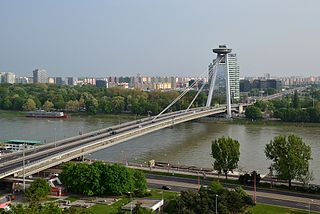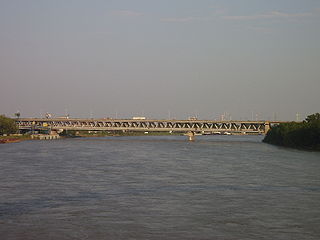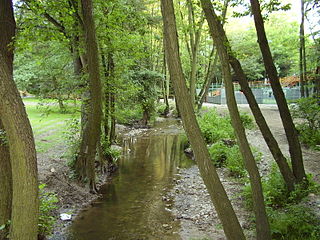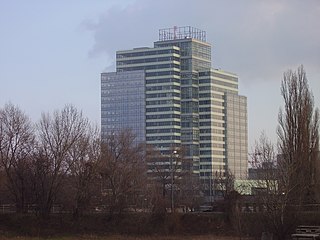
Petržalka is the largest borough of Bratislava, the capital of Slovakia. Situated on the right bank of the river Danube, the area shares a land border with Austria, and is home to around 100,000 people.

Most SNP, commonly referred to as Most Slovenského národného povstania or the UFO Bridge, and named Nový most from 1993 to 2012, is a road bridge over the Danube in Bratislava, the capital of Slovakia. It is the world's longest bridge to have one pylon and one cable-stayed plane.

The Bratislava Region is one of the administrative regions of Slovakia. Its capital is Bratislava. The region was first established in 1923 and its present borders exist from 1996. It is the smallest of the eight regions of Slovakia as well as the most urbanized, most developed and most productive by GDP per capita.

Apollo Bridge in Bratislava is a road bridge over the Danube in the capital of Slovakia. It is located between the Starý most and Prístavný most Bridges, a site which allowed almost perpendicular bridging, resulting in the shortest possible span.

Tehelné pole or National football stadium is a multi-use stadium in Bratislava, Slovakia. It was completed in 2019 and is used for football matches, including the home matches of ŠK Slovan Bratislava and the Slovakia national football team. This project concerns mutual assistance between well-known Slovak entrepreneur Ivan Kmotrík as the owner of ŠK Slovan Bratislava and the Government of Slovakia. The stadium has a capacity of 22,500 spectators, and replaced the old Tehelné pole stadium, which was demolished in summer 2013.
Bratislava V is an okres (district) of Bratislava in the Bratislava Region of Slovakia. It covers southern areas of Bratislava, including the boroughs of Petržalka, Jarovce, Rusovce and Čunovo. It is bordered by the Danube river to the north and east, which forms its borders with the Bratislava IV, Bratislava I, Bratislava II and Senec districts. It borders on Hungary in the south and Austria in the west. Until 1920, the northern part of the district was part of the Hungarian county of Pozsony, while the southern part was part of the county of Moson. It is the only Slovak district which is situated on the right bank of the Danube.

Lanfranconi Bridge is a concrete motorway bridge in Bratislava, Slovakia, located on the D2 motorway. It was built in 1985–1991, with its right half opened in 1990 and the rest in 1992. It is 766 m long, and has a 30 m wide four-lane motorway. There are lanes for cyclists and pedestrians as well. It crosses the Danube.

Starý most is a bridge over the river Danube in Bratislava, Slovakia. Before its reconstruction, the 460-meter-long (1,510 ft) bridge included a wooden pathway for pedestrians, a two-lane road, and a railway track, connecting the historic old city of Bratislava with the newer region Petržalka. The bridge was closed for cars in 2009 and for buses on 14 May 2010. On 2 December 2013 it was also closed for pedestrian and bicycle traffic as deconstruction of the old bridge began. At the time of its closure it was the oldest standing bridge in Bratislava.

Prístavný most is a double-floor motorway-railroad truss bridge over the Danube in Bratislava, Slovakia, near the Port of Bratislava. It lies on the D1 motorway. It is a 599 m long bridge, and was built between 1977 and 1985. There are also pathways for pedestrians and cyclists on the bridge.

Arena Theatre is one of the oldest theatres in Bratislava. It was established in 1828 on the right bank of Danube. In the beginning it served as an open summer amphitheatre, hence the name Arena. The current building was built in 1898.

Slovnaft is an oil refining company in Slovakia. The company, located in Bratislava, is a subsidiary of MOL Group.

The Port of Bratislava is a major port on the river Danube and — in a wider sense — on the Rhine-Main-Danube waterway, located in Bratislava, the capital of Slovakia. It is a universal inland port consisting of two parts, a cargo port and a passenger port. The former is a key facility for Slovakia's economy as the largest of three international ports in Slovakia, the others being in Komárno and Štúrovo. The port lies at the strategic intersection of the Rhine-Main-Danube Canal with the Baltic-Adriatic Corridor, part of the Trans-European Transport Networks, and it is located near two major ports: Port of Vienna and Port of Budapest.

Vydrica is a small 17 km long river in south-western Slovakia, which originates in the Little Carpathians mountains at about 450 m AMSL and flows into the Danube through the capital Bratislava.
Bratislava's geographical position in Central Europe has long made Bratislava a natural crossroads for international trade traffic. Various ancient trade routes, such as the Amber Road and the Danube waterway have crossed the territory of today's Bratislava. Today Bratislava is a road, railway, waterway and airway hub.

Eurovea is a business, retail and residential complex in Bratislava, Slovakia, in the Pribinova Zone at the border of Old Town and the borough or Ružinov, between the Old Bridge and the Apollo Bridge, bordered by Pribinova street from the north and the river Danube from the south. Eurovea connects the Bratislava Riverfront with the city center and offers stores and leisure time facilities while housing businesses, apartments and a Sheraton hotel. Phase I of the Eurovea complex was developed by Ballymore Properties at the cost of €350 million and it opened after four years of construction in 2010.

Aupark Tower is a high-rise building in Bratislava located in the district of Petržalka which is a part of the shopping center Aupark. It was built by the HB Reavis Group company in 2007. In 2012, Heitman European Property Partners IV purchased the building for €85.6m. Currently, the office space of the building is occupied by a number of tenants, including Telefónica O2 Slovakia, Eset, Procter & Gamble and AT&T, among others.

Bratislava is the capital and largest city of Slovakia. Officially, the population of the city is about 475,000; however, it is estimated to be more than 660,000 — approximately 150% of the official figures. Bratislava is in southwestern Slovakia at the foot of the Little Carpathians, occupying both banks of the River Danube and the left bank of the River Morava. Bordering Austria and Hungary, it is the only national capital that borders two sovereign states.
Bratislava bridgehead is found in the western part of Slovakia. It has an area of 93,7 square km. It is situated on the Little Hungarian Plain, on the left bank of the river Danube. Administratively, it belongs to the district Bratislava V in Bratislava, and has 111,135 inhabitants.
The architecture of Slovakia has a long, rich and diverse history. Besides Roman ruins, Slovakia hosts several Romanesque and Gothic castles and churches, most notably Spiš Castle, which were built at the time of the Kingdom of Hungary. Renaissance architecture was of particular relevance in town hall squares, such as in Bardejov and Levoča. Affluent architecture in the following centuries made use of Baroque, Rococo and historicist styles, while vernacular architecture in the countryside developed a specific style of wooden houses and wooden churches. In the 20th century, Slovakia knew Art Nouveau and modernist architecture, including socialist modernism, and finally contemporary architecture.














